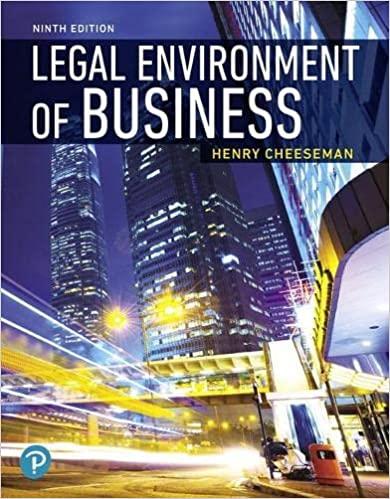Question
1. Reagan was employed as a labourer by the City of Toronto, Ontario. On September 12, 2011, Reagan was sent to the Toronto City Park
1. Reagan was employed as a labourer by the City of Toronto, Ontario. On September 12, 2011, Reagan was sent to the Toronto City Park and instructed to plant a row of saplings along the property line between the City Park and the neighbouring property, owned by Janeth. While the city supplied the saplings, Reagan had to provide his own tools and materials. Reagan went to the City Park and began to dig holes for the saplings along what he believed was the city's side of the dividing line between the properties. He was relying on stakes that were erroneously placed by the City of Toronto on Kenneth's property.
After he had dug several holes, Janeth came out of her house and advised Reagan that he was digging on her property. She ordered him to leave. Reagan became enraged and swung his shovel at Janeth, narrowly missing her head. Frightened that Reagan would strike her, Janeth jumped backwards. But she tripped and broke her ankle. She then got up and went inside.
Hobbling, a few minutes later, Janeth returned from her house holding her Beretta 92FS semiautomatic pistol. Pointing the gun at Reagan, who was still packing up his equipment, Janeth shouted, "Get the fxxx off my property now, asshole!" Reagan was pretty scared and immediately jumped in his truck and drove away.
Identify all the intentional tort:
a. that Janeth might reasonably assert against Reagan
b. that Reagan might reasonably assert against Janeth
Outline their elements and discuss with specific examples from the facts of the question.
2. Plaintiffs were owners of a ship called the Tarleton. Plaintiff fitted the ship with hopes of trading with the natives on the Cameroon coast. The captain of the Tarleton sent a smaller vessel called the Bannister loaded with goods to another part of the coast to trade with natives. Natives began to visit the Bannister when Defendant's ship, the Othello, shot on them with a cannon, killing one of them. Plaintiff alleged that Defendant did this so that the natives would not trade with Plaintiff. Plaintiff called the commander of the Bannister to testify at trial and the facts as stated were so proved. On cross-examination, it was admitted that by custom, no Europeans can trade until a duty was paid to the king of that country and that Plaintiff had in fact not paid that duty. Defendant contended that Plaintiff was engaged in illicit trade and that the law should not support his cause of action.
Identify and discuss the applicable intentional tort outlining the elements and discussing it with relevant examples from the facts of the question.
Step by Step Solution
There are 3 Steps involved in it
Step: 1

Get Instant Access to Expert-Tailored Solutions
See step-by-step solutions with expert insights and AI powered tools for academic success
Step: 2

Step: 3

Ace Your Homework with AI
Get the answers you need in no time with our AI-driven, step-by-step assistance
Get Started


